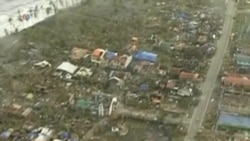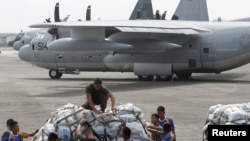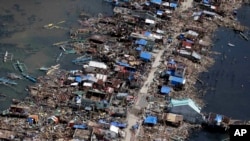MANILLA —
In the Central Philippines authorities are struggling to reach many of the some 600,000 people displaced by Super Typhoon Haiyan. Officials anticipate a death toll in the thousands.
At the Villamor Air Force Base in Manila, C130 planes filled with relief goods are headed to one of the hardest hit cities, Tacloban in Leyte Province.
Some relief organizations say their provisions are taking three times longer to get there because so many land routes have been blocked by massive piles of debris from fallen houses and trees.
On the other side of the air field, around 400 people are waiting for a chance to catch a ride on one of the planes headed toward the devastation zone.
Among them is Tito Lucinareo, a father of two boys from a small town 25 kilometers outside Tacloban. He says he did manage to get a call through to one of his brothers who said the children survived the storm. But Lucinareo is not sure if they have food.
He says, “You think about whether your child is eating. Is he hungry? He likes to eat, especially biscuits.”
Lucinareo, his brother and cousins packed bags full of food that they plan to take to their hometown on foot.
Some in Tacloban have resorted to looting with reports of grocery stores and shopping malls being ransacked by people in search of food and clean water. The government said Sunday it would send additional military and police personnel to try to restore order.
While the C130 planes were readying to take off, the Presidential Cabinet Secretary Rene Almendras briefed reporters on state-run television. He laid out some of the government’s biggest challenges in trying to manage the crisis.
Almendras says for moving the goods alone, there are “so many operational details and humps to be worked out.”
“I don’t know how to describe it. Every single square foot of C130 space or every pound of C130 capacity from Manila to Tacloban is critical and how fast we can turn around the planes and so many other details, the fuel for the planes and all that,” he said.
Almendras also says that not knowing whether it is safe to pass certain routes has been a problem. He says the national government needs access to local government knowledge of the different villages so military and national responders can reach those areas.
In small increments communication lines are being restored to the less devastated locations. But in the worst-hit areas, power is out and cell phone service has been intermittent at best.
At the Air Force Base, Nelida Palconite says she was not sure whether she could get on the flight to go home to Tacloban. So she made this plea.
“We need food, we need… everything that you could give us. Medicines, water,” she said.
An Armed Forces spokesman says “the whole situation is really a challenge” the military has to overcome.
At the Villamor Air Force Base in Manila, C130 planes filled with relief goods are headed to one of the hardest hit cities, Tacloban in Leyte Province.
Some relief organizations say their provisions are taking three times longer to get there because so many land routes have been blocked by massive piles of debris from fallen houses and trees.
On the other side of the air field, around 400 people are waiting for a chance to catch a ride on one of the planes headed toward the devastation zone.
Among them is Tito Lucinareo, a father of two boys from a small town 25 kilometers outside Tacloban. He says he did manage to get a call through to one of his brothers who said the children survived the storm. But Lucinareo is not sure if they have food.
He says, “You think about whether your child is eating. Is he hungry? He likes to eat, especially biscuits.”
Lucinareo, his brother and cousins packed bags full of food that they plan to take to their hometown on foot.
Some in Tacloban have resorted to looting with reports of grocery stores and shopping malls being ransacked by people in search of food and clean water. The government said Sunday it would send additional military and police personnel to try to restore order.
While the C130 planes were readying to take off, the Presidential Cabinet Secretary Rene Almendras briefed reporters on state-run television. He laid out some of the government’s biggest challenges in trying to manage the crisis.
Almendras says for moving the goods alone, there are “so many operational details and humps to be worked out.”
“I don’t know how to describe it. Every single square foot of C130 space or every pound of C130 capacity from Manila to Tacloban is critical and how fast we can turn around the planes and so many other details, the fuel for the planes and all that,” he said.
Almendras also says that not knowing whether it is safe to pass certain routes has been a problem. He says the national government needs access to local government knowledge of the different villages so military and national responders can reach those areas.
In small increments communication lines are being restored to the less devastated locations. But in the worst-hit areas, power is out and cell phone service has been intermittent at best.
At the Air Force Base, Nelida Palconite says she was not sure whether she could get on the flight to go home to Tacloban. So she made this plea.
“We need food, we need… everything that you could give us. Medicines, water,” she said.
An Armed Forces spokesman says “the whole situation is really a challenge” the military has to overcome.











